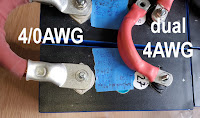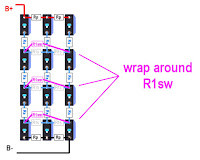Ok, so we found out that the star topology clearly outperforms the others in terms of stability and homogeneous currents / aging across the cells.
But what if someone is stuck with another topology ?
Is it possible to improve their performance, outside of changing wire gauge if too small or cleaning / lapping the terminals ?
First, in case of a same side topology, since it is the worst, the first thing to do is to move the B+ and B- pick up points to get to a midpoint or opposite topology.
Decreasing Rp
Since most of the imbalances are due to the resistance between the strings where the main B+ & B- pick up points are and where the Max currents occur, what if this resistance is decreased ?
Well, our current value of 0.15mΩ for these Rp interconnects is already pretty gosh dang good. Replacing those dual-4AWG wires with a massive 4/0AWG wire did not improve the cell-terminal-to-cell-terminal resistance:
That could be improved by changing the lugs. But even then it is not likely to get much better than 0.15mΩ. Because the length is so short, the wire resistance is relatively small compared to the resistance of the crimps + lugs + contact areas.
That could also be improved by switching to beefy rigid busbars, but these were ruled out for this van due to the expansion / contraction of the cells during charging / discharging, and due to the mobile nature of a van that implies high levels of vibration.
So what else can be done ?
Add a wrap-around Rpw interconnect
The current asymmetries at the B+ and B- pick up points are mostly due to the difference in the number of Rp interconnects for the current to reach this or that string. Adding a connection between the leftmost and rightmost string should decrease the current imbalance for some topologies:
The Rpw resistance will bit a tad higher than Rp as its cable needs to be ~5" longer to connect those two distant LF280 cells. So let's assume 0.2mΩ instead of 0.15mΩ. Sim results for the opposite corners topology:
 |
| No Rpw: Max= 73A, Min= 35A, Settling: >6h |
 |
| Rpw= 0.2mΩ: Max= 64A, Min= 42A, Settling: 4.2h |
Much improved, from a 38A delta down to 22A. That's a keeper !
How about the midpoint topology ? No gains expected there since this topology is already center symmetrical. Adding more center symmetrical current paths won't change anything, except marginally increasing resilience in case of resistance variations between the Rp interconnects.
Add wrap-around 1S interconnects
Well, if it worked for Rp, it should for R1s too, right ?
Wrong ! This is another case where intuition fails us, and why doing sims can help bigly.
In the opposite corners topology, it again provides more paths for cells to push current through the already working hard cells near the B+ & B- pick up points. Resulting in worse current imbalances:
 |
| R1sw= 0.5mΩ Rpw= 0.2mΩ: Max= 68A, Min= 39A, Settling: 3h |
And it does not do anything for the midpoint topology as these additions are also center symmetrical.
Conclusions
- If same side topology 🠚 move to one of the other two
- If opposite corners 🠚 add wrap-around Rpw interconnects. It improves current imbalances and makes this topology equal to, or marginally better than, midpoint
- If midpoint 🠚 no additional improvements. Probably not worth moving to opposite corner + Rpw
Now, these results are valid for a 4S3P pack, but will change depending on the pack architecture, on the cell type, etc.
For instance, for 4S5P, a modified opposite corners topology might perform better than midpoint if the B+ & B- pick up points are moved to the 2nd and 4th string. Thus becoming a '2/5th opposite corners' topology. Then, additional Rp / Rpw jumpers between distant cells should decrease imbalances even more.
Another example: the 48V packs used in many solar systems typically do not use many strings within a 1-BMC pack, but can use many 1-BMC packs in parallel. BMC or not, the same electrical imbalance effects will take place for a given wiring topology. Depending on the number of strings, Rp jumpers and Max total current, it will be key to pick an optimal topology, like star, or some strings will work notably harder than others.
All right, the cows have come home. Time to finish this Winter pack build !









Comments
Post a Comment